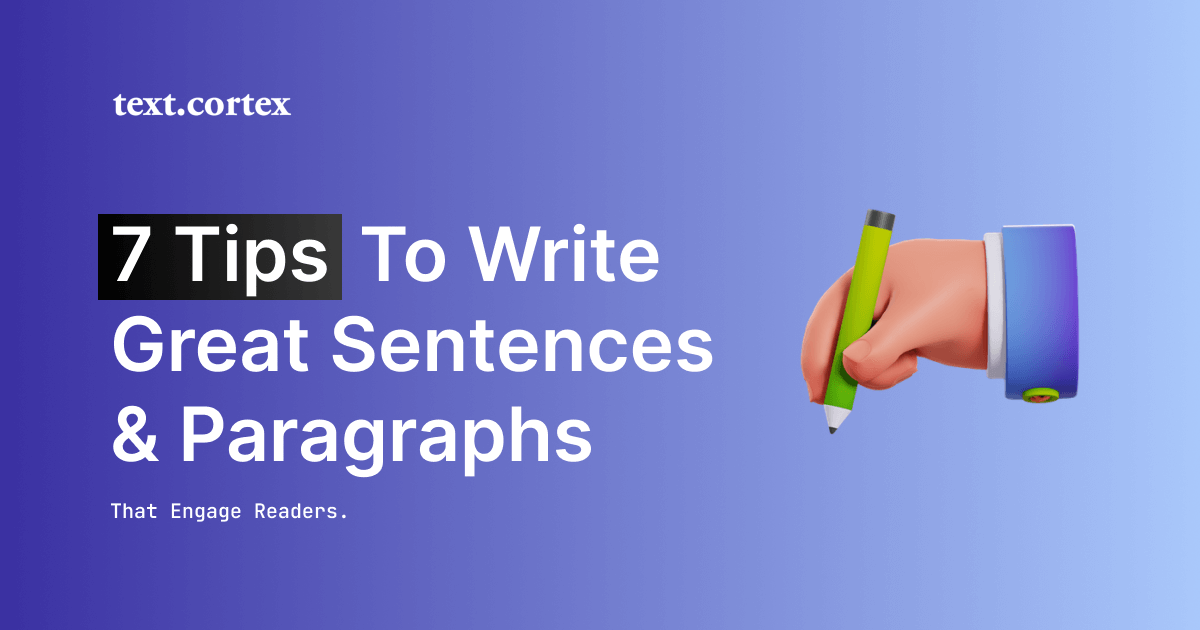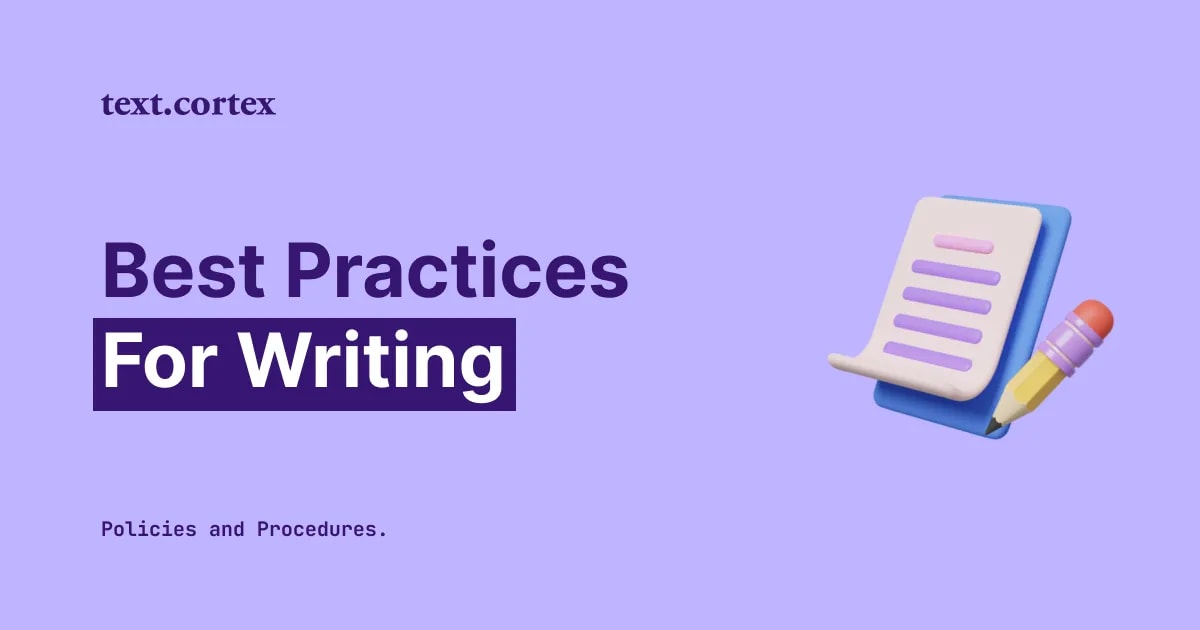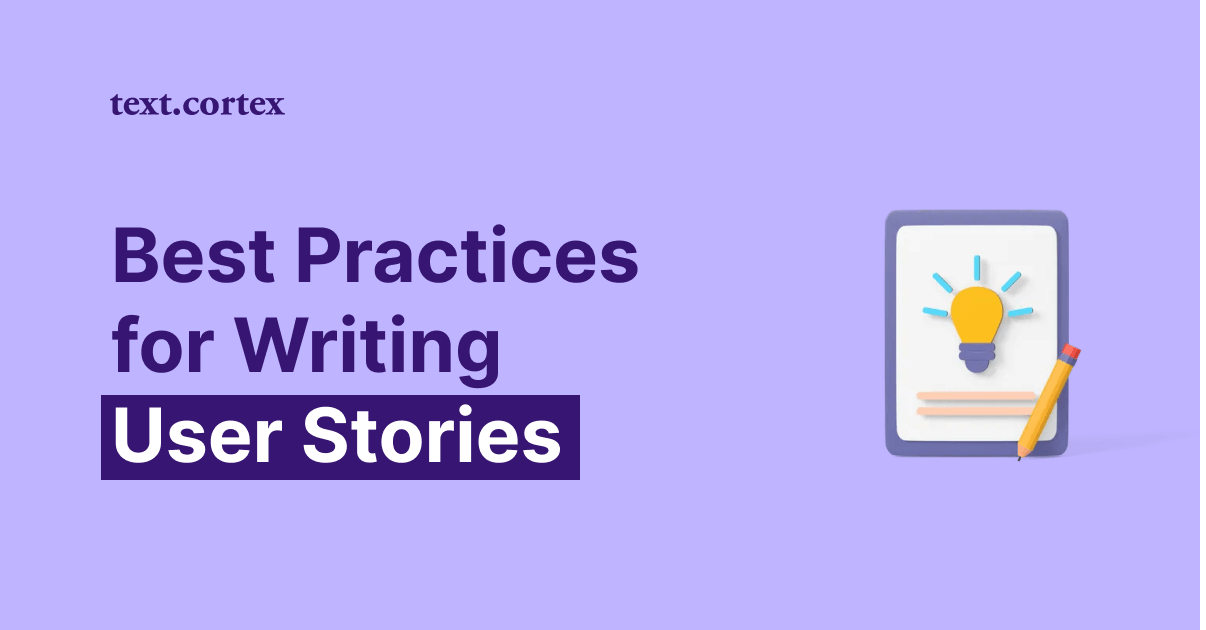Did you know that how-to articles are the most popular content formats (77%), followed by news and trends (49%), and guides and ebooks (47%)?
Articles are the logical and orderly presentation of ideas with an explanatory, persuasive, and educational purpose.
If you want your audience to take something away from your writing, you must first develop an attractive, intelligent, and articulate idea that you want to present.
Those ideas are illustrated in the form of paragraphs that build each notion through a series of phrases — they aim to explain, contextualize, and enrich each concept.
To hook more readers to your content, you need to shape your paragraphs in an appropriate way to express these ideas and meet readers' expectations.
With this in mind, we will provide you with a list of 7 easy steps on how to write good sentences and paragraphs to improve your content structure and make it more engaging.
By following these steps, you will be able to organize your ideas more accurately and create more pleasing and catching articles that will drive more leads to your websites.
Let’s check that out.
Why Writing Good Paragraphs Is Important?
The sentence itself is the building block, the granular element that you must create to convey one's message successfully.
There are many ways to play this “game”, but nothing beats the challenge of creating an uncredited masterpiece such as "Items trapped in doors cause delays."
You can rephrase this sentence to sound like this: "Remove all obstacles from the door before you attempt to open it."
However, with paragraphs, you want to encourage and illustrate the creativity that goes into such a sentence to learn mastery skills of talented writing.
These nuts and bolts reveal a new angle on what it means to become a good writer depending on one's point of view.
A well-organized paragraph helps your readers to:
- Stay focused on the content
- Develop trust in your claims
- Easily remember the context of the text
- Be inspired to read more
Sentences are our means of communication, the grounds we all share as authors.
Therefore, the purpose of every writer is to write a sentence as clear and "handsome" as it is original.
Paragraphs gather all those sentences in a group to represent one of the many aspects of the message we are trying to convey — and that is why they are vital in the writing process.
7 Tips On How To Write Catchy Sentences And Paragraphs?
1. Create Main Idea

A paragraph should be a unit of thoughts— it bundles your knowledge about a particular aspect of your text.
The general rule when writing a paragraph is only to include one fact and one supporting idea at a time.
Start a new paragraph if you want to build upon that point.
A single paragraph can contain one piece of information and multiple related points, but not if they get too long.
Keep in mind your content’s readability when creating your paragraphs to avoid readers losing their interest because the text is overwhelming for consumption.
Let’s check this on the following paragraph by James Baldwin, which I will use as an example of each step within this article.
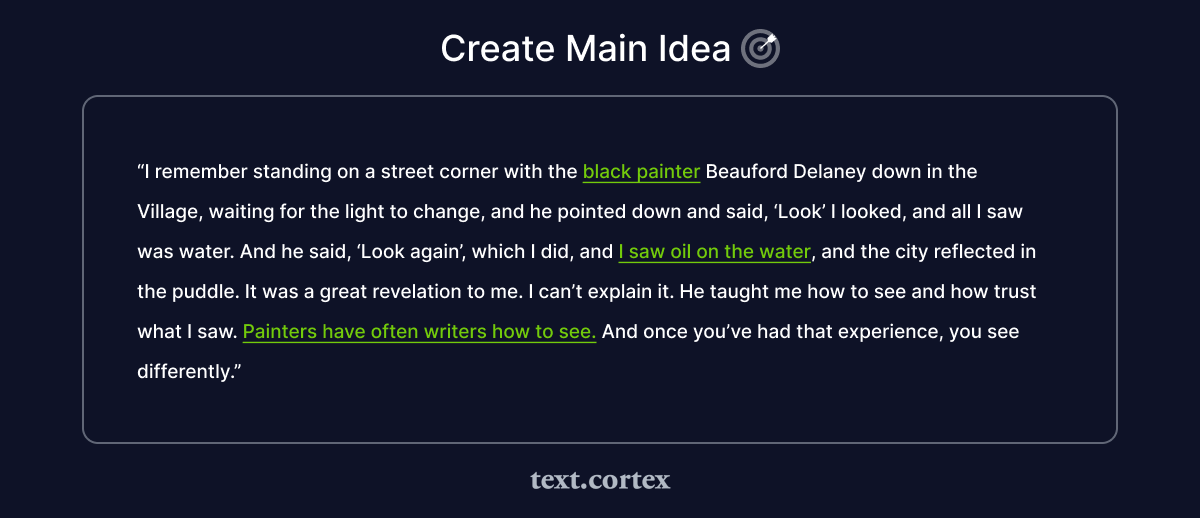
The main idea behind this example is that the painters often teach writers how to see, and everything before and after that announcement leads and justifies that main idea
Think about your paragraph as a seed from which all your compelling sentences should start to grow and develop until they bloom.
Each paragraph you write should “announce” and justify the idea you are representing in it.
2. Follow Paragraph Structure
To follow paragraph structure, think of it as the article outlines you use to map topic transitions from one key point to another.
It helps you better organize your thoughts in a logical flow to support the main idea.
Let’s assume that you have an idea of how you want to construct your thesis.
Each paragraph in the document should be structured as follows:
- Harmonized — All sentences should be related to the main idea.
- Coherent — Sentences should be logically organized and follow a progression pattern.
- Well-crafted - You should explain every point that you make in the paragraph.
Although there are no strict rules for how many paragraphs you can have in a text, you should always pay attention to follow its context.
So put a new paragraph if, for example:
- You want to add a few sentences related to the paragraph above.
- Presenting someone else’s point of view or changing point of view in general
- You are addressing something new related to the main idea
Let’s see how that looks in the example:
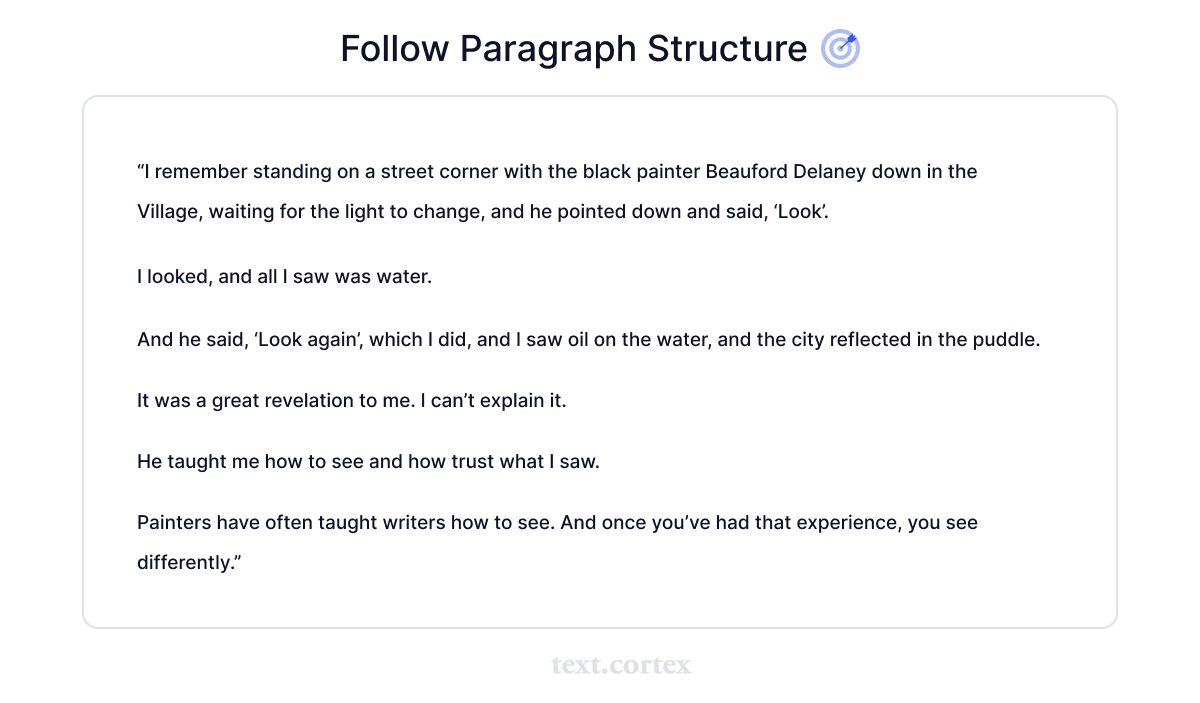
Even though this example initially is one paragraph, you can nail it down to multiple paragraphs without losing the context of the main idea.
As long as your paragraphs have a flow like they are “telling a story,” it is ok to put them into smaller sections so the reader can consume them lightly.
3. Back-Up Main Idea With Examples
People love examples in articles because they can easily visualize, remember and put to practice the information you are providing.
Examples are an essential part of your paragraphs because they give your content credibility, making readers believe you are a trustworthy source.
They are the “loudest” key players responsible for seducing the readers and gaining attention.
Your examples can be in the form of an opinion, a citation of a relevant expert on the subject, a statistical fact, or simply your personal story to convey the impression.
In our example, you can see that paragraph is a form of testimony — an excellent way to convince someone to trust your words:

Conversely, this paragraph can sound like this as well:
"I remember how painter Beauford Delaney taught me about a different perspective of seeing things in life by just looking at a simple puddle of water reflecting the city. "
This summarized version of the story includes all relevant details — you can agree, right?
But does it feel the same? Well, no.
With that said, It is not enough just to state something and to expect people to believe your words, so back those statements with relevant examples.
That way, you can provoke readers' curiosity and make them linger on your content till the end.
4. Elaborate Examples To Prove Your Point
Now that we have examples in our paragraph, we want to ensure that the readers get our point.
We can establish that by explaining why the examples we use are relevant for such a statement or the topic itself.
Another reason this is an integral part of the paragraph is that you engage your readers – this is where they agree, disagree, sympathize, relate, or disagree with your viewpoint.
A good argument will keep readers’ eyes on your content till the end.
Let’s see how that works in our example:
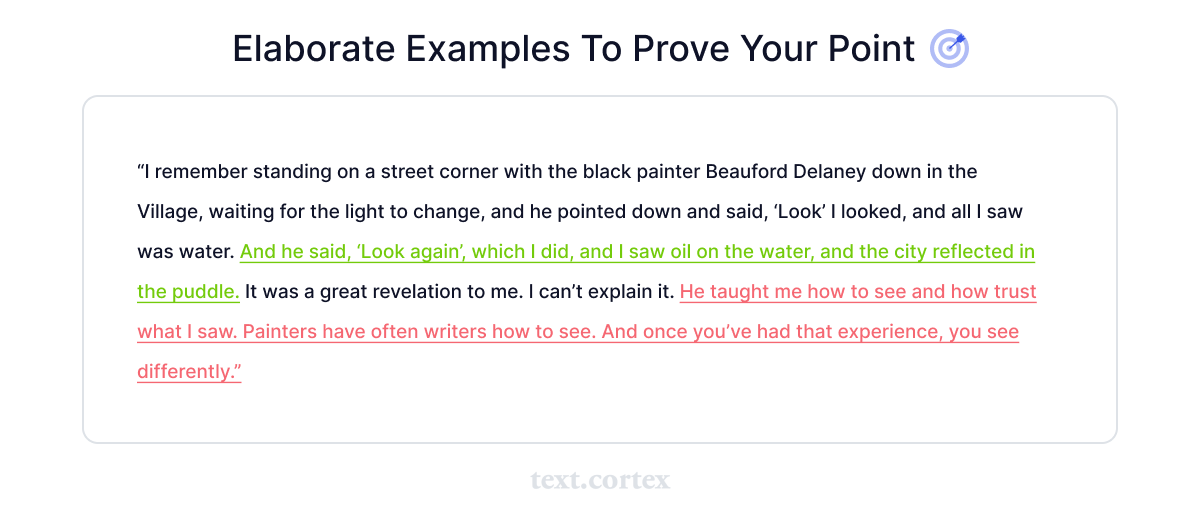
By making sure that all your statements and examples have the appropriate finish in the form of an explanation, you can establish your content as a relevant source of solutions.
This is a good writing practice to ensure your audience remains true to your brand, website, or page.
5. Use Transition Words And Phrases
Paragraphs representing the same concepts and ideas must be related to one another in the paragraph's natural progression.
It's usually necessary to carry multiple thoughts from one sentence to the other.
Not doing so is similar to creating a sharp turn in one's driving path, which may happen when someone doesn't use proper signals.
You must ensure that the sequence of paragraphs has a logical relationship for the reader.
Let's see transitions between paragraphs in our example:
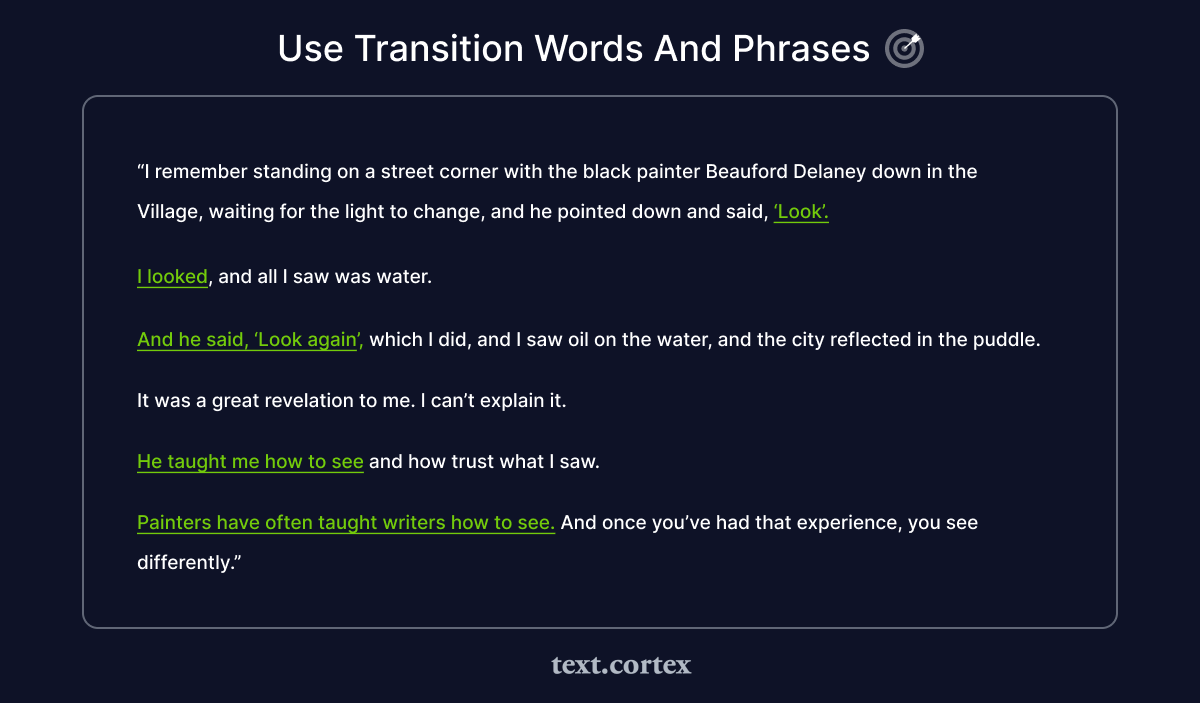
Suppose a relationship between paragraphs exists but is not immediately apparent to the reader.
A trick is to connect the last sentence of one paragraph with the next, or vice versa.
The normal progression of thoughts is from the broadest to the narrowest.
If you are unsure how to start, here is a list of the most common transition words you can use to content two paragraphs and express your thoughts easily.
6. Use Active Voice
It's good to prioritize using the active voice in your paragraphs.
Passive voice sentences tend to be more wordy, sound vague, and very hard to consume.
It can sometimes tangle up words, so your readers struggle to understand the sentence's meaning instead of focusing on the point of the sentence.
Furthermore, the experience of reading active voice sentences gives it an entirely new meaning.
Let's see the difference in impression when we translate sentence from passive voice to active voice.
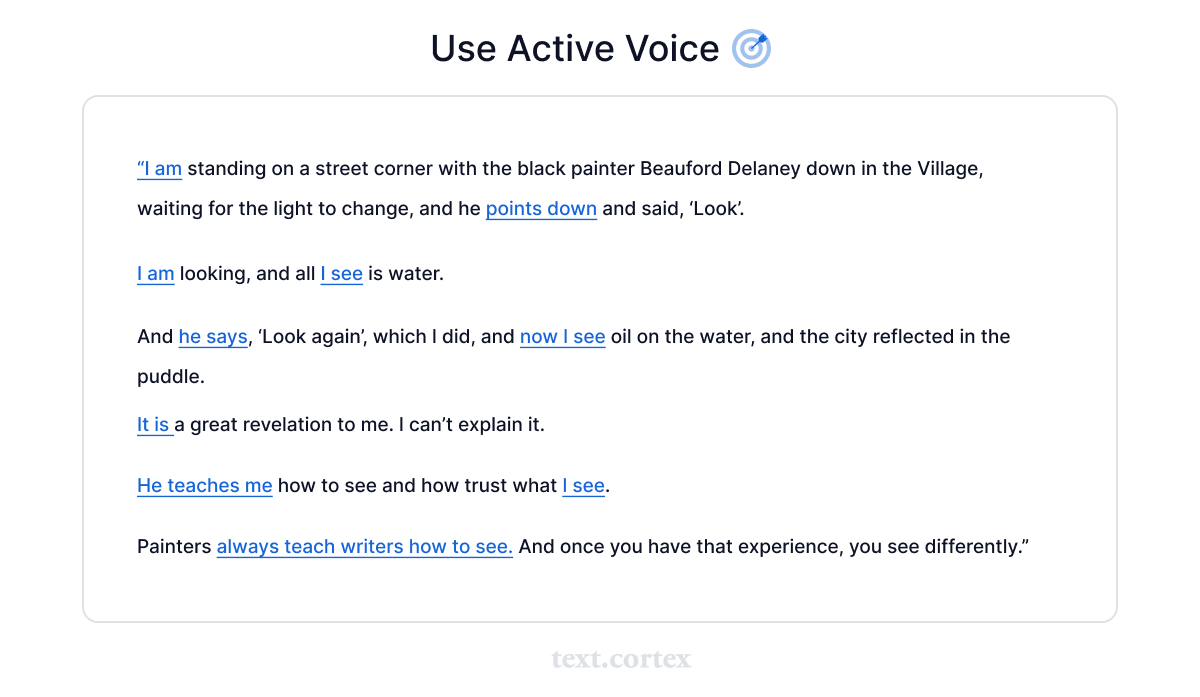
If you write your sentences in an active voice and present simple tense, your content will sound more convincing, and your readers will be able effortlessly to comprehend your message.
7. Proofread Your Paragraphs
Once you wrap things up, read back over your work.
There might be some errors that are easy to skip over in your head but are blatantly obvious when you see them.
Read through your paragraph 2-3 times to check for grammar mistakes or misspelled words.
If you want to shorten your sentences and make them clearer, make sure there aren't any that start but don't end (thereby creating fragments).
At the same time, if you want to make longer sentences, you must include both a subject and a verb to generate a complete notion.
This way, you can avoid reader confusion, as they will struggle to comprehend an incomplete thought.
Additionally, awkward punctuation can disrupt the flow of individual sentences and the entire course.
And finally, correct periods, commas, semi-colons, and other punctuation aid in the sophistication of your writing.
Proofreading is all about ensuring that you deliver a high-quality product so that your readers can focus on reading your post without distractions.
To Sum Up
We hope that this list will assist you in improving your writing skills and molding your words into flawless paragraphs that will amaze your readers.
When it comes to writing, you must begin at the beginning — start writing at the sentence level.
Words are powerful — you can use them to build up or tear down, encourage or discourage, inform or misinform.
Paragraphs and sentences help you express your thoughts and emotions, share knowledge, sell the product, get a job, etc.
Thus, strong writing skills are essential for your business and life success.
If you love making money from writing, encourage yourself to track your writing progress and strive to become better with every article you are presenting to your audience.
On the other hand, we have to admit that perfection in writing does not come with a magic stick.
Or does it?
What if we tell you that everything you read today can go away with just a couple of simple clicks?
This is probably not your first article to read about pieces of advice on how to improve your writing skills and make your content sound more proficient and engaging.
Yet, you know that even enormous efforts take a lot of time to show results when you need to do those things manually.
Luckily, TextCortex has a solution for your problems.
It can take 70% of your writing time and help you produce 10x more content than you can write manually.
With the new rephrasing extension, you can have your personal AI writing assistant that wipes all those tedious writing mistakes from your plate.
Your sentences will become error-free, sound more confident, and proficient in every textbox you use.
You only need to highlight the sentence or paragraph that you want to paraphrase, hit the "Rewrite" button, and choose the output that fits your needs best.
With TextCortex rewriting extension you can:
- Transform your bullet points to email
- Generate the blog’s body with a single sentence
- Rephrase your paragraphs for better context
- Autocomplete your thoughts
- Summarize your text to sound more effective
- Adjust the tone of voice to target your audience effectively
Download TextCortex Chrome extension and take over tiring writing headaches and skyrocket your writing skills and business opportunities.

